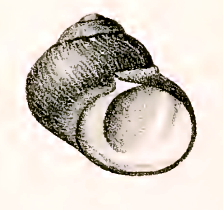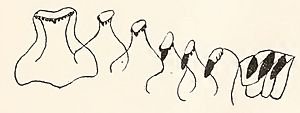Diloma nigerrimum facts for kids
Quick facts for kids Diloma nigerrimum |
|
|---|---|
 |
|
| Drawing of a shell of Diloma nigerrimum | |
| Scientific classification | |
| Synonyms | |
|
The bluish top shell (Diloma nigerrimum) is a type of small sea snail. It's a marine (ocean-dwelling) gastropod, which means it's a snail that lives in the sea. This snail belongs to the Trochidae family, also known as the top snails, because of their shell shape.
Contents
What Does the Bluish Top Shell Look Like?
The shell of the bluish top shell is usually about 24 mm (almost an inch) tall and 26 mm wide. It's a strong, black shell that's a bit flattened and round, like a globe.
Shell Features
- Surface: The shell has many thin, spiral lines, almost like tiny grooves. These lines are crossed by other lines that show how the shell grew over time.
- Color: The shell is typically bluish-black or completely black. If you find one washed up on the beach, it might look reddish or brownish. It doesn't have any spots.
- Outer Layer: The outside layer of the shell is quite thick and shiny when the snail is fresh.
- Shape: The top part of the shell, called the spire, is short and shaped like a cone. The very tip, or apex, can be rounded or pointy.
- Whorls: The shell has 4 to 5 whorls, which are the turns or spirals of the shell. They grow bigger quickly. The last and largest whorl, called the body whorl, is often a bit sunken below the seam (suture) where the whorls join.
- Base: The bottom of the shell is rounded. It can look worn or shiny (iridescent) near the opening.
- Opening: The shell has a large, slanted opening called the aperture. It often has a greenish, shiny look inside.
- Lip: The outer edge of the opening is thin and sharp. It has a very thin black border, followed by a wide white band that can be very shiny.
- Central Pillar: Inside the shell, there's a central pillar called the columella. It's wide and flat, mostly made of a white layer.
Even though the tiny "teeth" on the tongue-like structure (called a radula) of snails from New Zealand look different from those in South America, scientists have used genetic tests to confirm they are all the same species of Diloma nigerrimum.
Where Do Bluish Top Shells Live?
This sea snail lives in the ocean. You can find it along the coast of New Zealand and on the west coast of South America.
See also
 In Spanish: Diloma nigerrimum para niños
In Spanish: Diloma nigerrimum para niños


